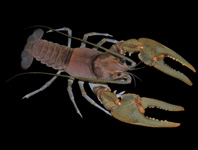Abstract
Four new species of the chordeumatidan millipede genus Nepalella Shear, 1979, family Megalotylidae, are described from caves in southern China: N. troglodytes sp. nov., N. lobata sp. nov., N. jinfoshan sp. nov., and N. wangi sp. nov. Three of them (except N. lobata sp. nov.) are presumed troglobites. Additional locality records of two cave congeners, N. caeca Shear, 1999 and N. grandoides Golovatch, Geoffroy & Mauriès, 2006, are also provided. DNA-barcoding based on the COI mitochondrial gene is documented in this genus and for species of the order Chordeumatida outside Europe for the first time. Interspecific p-distances between Nepalella species amount to 8.5–15.9%, while intraspecific p-distances are 0–6.8%. The species of Nepalella are found to show a surprisingly low genetic distance from the European genus Atractosoma Fanzago, 1876, family Craspedosomatidae Gray in Jones, 1843, potentially based on the very limited number of barcoding sequences of the order Chordeumatida being available.
References
Altschul, S.F., Madden, T.L., Schäffer, A.A., Zhang, J., Zhang, Z., Miller, W. & Lipman, D.J. (1997) Gapped BLAST and PSI-BLAST: a new generation of protein database search programs. Nucleic Acids Research, 25 (17), 3389–3402.
https://doi.org/10.1093/nar/25.17.3389Astrin, J.J. & Stüben, P.E. (2008) Phylogeny in cryptic weevils: molecules, morphology and new genera of western Palaearctic Cryptorhynchinae (Coleoptera: Curculionidae). Invertebrate Systematics, 22 (5), 503–522.
https://doi.org/10.1071/IS07057Decker, P. (2016) Phylogenetic analysis of the Australian trans-Bass Strait millipede genus Pogonosternum (Carl, 1912) (Diplopoda, Polydesmida, Paradoxosomatidae) indicates multiple glacial refugia in southeastern Australia. Zookeys, (578), 15–31.
https://doi.org/10.3897/zookeys.578.8052Enghoff, H., Golovatch, S.I., Short, M., Stoev, P. & Wesener, T. (2015) Diplopoda. IN: A. Minelli (Ed.), Treatise on zoology—anatomy, taxonomy, biology. The Myriapoda, 2 (16), 363–453.
https://doi.org/10.1163/9789004188273_017Fanzago, D.F. (1876) Nuove contribuzioni alla fauna miriapodologica italiana. Tipografia di Paolo Toschi E C, 1–23.
Felsenstein, J. (1985) Confidence limits on phylogenies: An approach using the bootstrap. Evolution, 39 (4), 783–791.
https://doi.org/10.2307/2408678Golovatch, S.I. (1984) Contributions to the millipede fauna of Vietnam (Diplopoda) II. Acta Zoologica Hugngarica, 30 (1–2), 53–77.
Golovatch, S.I., Geoffroy J.-J. & Mauriѐs J.-P. (2006a) Four new Chordeumatida (Diplopoda) from caves in China. Zoosystema, 28 (1), 75–92.
Golovatch, S.I., Geoffroy, J.-J. & Mauriѐs, J.-P. (2006b) Several new or poorly-known cavernicolous millipedes (Diplopoda) from southern China. Arthropoda Selecta, 15 (2), 81–89.
Hall, T.A. (1999) BioEdit: a user-friendly biological sequence alignment editor and analysis program for Windows 95/98/NT. Nucleic Acids Symposium Series, 41, 95–98.
Howarth, F.G. (1983) Ecology of cave arthropods. Annual Review of Entomology, 28 (1), 365–389.
https://doi.org/10.1146/annurev.en.28.010183.002053Mauriès, J.-P. (2005) Guizhousoma latellai gen. n., sp. n., from continental China, type of a new family of the superfamily Neoatractosomatoidea (Diplopoda: Chordeumatida). Arthropoda Selecta, 14 (1), 11–17.
Pimvichai, P., Enghoff, H., Panha, S., & Backeljau T. (2016) A revision of the Thyropygus allevatus group. Part V: Nine new species of the extended opinatus subgroup, based on morphological and DNA sequence data (Diplopoda: Spirostreptida: Harpagophoridae). European Journal of Taxonomy, 199, 1–37.
https://doi.org/10.5852/ejt.2016.199Shear, W.A. (1979) Diplopoda from the Nepal Himalayas. Chordeumida with comments on the Asian chordeumid fauna. Senckenbergiana Biologica, 60 (1/2), 115–130.
Shear, W.A. (1999) A new troglobitic millipede of the genus Nepalella from China (Diplopoda, Chordeumatida, Megalotylidae). Myriapodologica, 6 (1), 1–10.
Shear, W.A. (2002) Five new Chordeumatidan Millipedes from China: New species of Vieteuma (Kashmireumatidae) and Nepalella (Megalotylidae). Proceedings of the California Academy of Sciences, 53 (6), 62–72.
Shear, W.A. (2011) Class Diplopoda de Blainville in Gervais, 1844. Animal biodiversity: An outline of higher-level classification and survey of taxonomic richness. Zootaxa, 3148, 159–164.
Spelda, J. (2001) Review of the millipede genus Pterygophorosoma Verhoeff, 1897 (Diplopoda, Chordeumatida, Craspedosomatidae). Andrias, 15, 29–48.
Spelda, J., Reip, H., Biener, U.O. & Melzer, R. (2011) Barcoding Fauna Bavarica: Myriapoda–a contribution to DNA sequence-based identifications of centipedes and millipedes (Chilopoda, Diplopoda). ZooKeys, 156, 123–139.
https://doi.org/10.3897/zookeys.156.2176Tamura, K., Stecher, G., Peterson, D., Filipski, A. & Kumar, S. (2013) MEGA6: Molecular Evolutionary Genetics Analysis version 6.0. Molecular Biology and Evolution, 30, 2725–2729.
https://doi.org/10.1093/molbev/mst197Tavaré, S. (1986) Some probabilistic and statistical problems in the analysis of dna sequences. Lectures on Mathematics in the Life Sciences. (American Mathematical Society), 17, 57–86.
Wesener, T. (2015) No millipede endemics north of the Alps? DNA-Barcoding reveals Glomeris malmivaga Verhoeff, 1912 as a synonym of G. ornata Koch, 1847 (Diplopoda, Glomerida, Glomeridae). Zootaxa, 3999 (4), 571–580.
https://doi.org/10.11646/zootaxa.3999.4.7Wesener, T., Le, D.M.-T. & Loria, SF. (2014) Integrative revision of the giant pill-millipede genus Sphaeromimus from Madagascar, with the description of seven new species (Diplopoda, Sphaerotheriida, Arthrosphaeridae). ZooKeys, 414, 67–107.
https://doi.org/10.3897/zookeys.414.7730Wesener, T., Raupach, M.J. & Decker, P. (2011) Mountain refugia play a role in soil arthropod speciation on Madagascar. A case study of the endemic giant fire-millipede genus Aphistogoniulus (Diplopoda, Spirobolida, Pachybolidae). PLoS One, 6 (12), 1–15.
https://doi.org/10.1371/journal.pone.0028035

